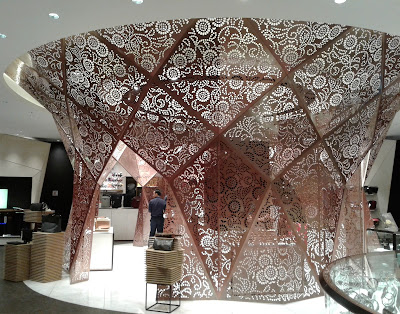Yep, I'm giving this a go. Even though the main campaign is aimed at Europe and N America.
Plastic bottles and bags are a worry, ecologically. But had you ever thought of the humble straw... and the damage it can do en masse?
Straws are such insignificant things, and tbh we often don't think about or (more importantly) need them when we use them. But they also play an unpleasant role in polluting our oceans and food-chains. As the placard says, a plastic straw takes 200 years to break down. And before it does, the plastic clogs up our oceans, can get ingested (often fatally) by sea creatures. When it finally disintegrates - even worse - it becomes tiny toxic particles, which permeate our oceans and their residents. (That's alongside all the bags and bottles which are doing the same things.)
Perhaps not so insignificant, after all?
So I'm going to try to stop using them. Or at least drastically cut down. SE Asia (where I am living now) is really not very good on care for the environment. Compared to Europe, anyway. I know the affluent EU traditionally has some of the world's best scores for being eco-friendly, and kids have grown up being educated about it for some decades. But it's sometimes shocking to see the use and misuse (and mis-disposal, and complete lack of care) regarding plastic over here in Asia. The situations for a lot of developing, or nearly-developed countries is quite different. I know that there are potentially more pressing things economically for a lot of SE Asian countries. Plus a whole raft of other hurdles such as education, corruption etc to jump before even embarking on this slow journey of change. But actually, I have a sneaky feeling that eco care has become important for everyone now, regardless. If the planet gets screwed, then frankly we're all stuffed!
I'm not an eco warrior, and I have no intention of preaching to anyone. This is just my own effort whilst living in the tropics. Let's see how it goes!
#RefuseTheStraw Week 1
Obstacle 1. This guy!
This is the traditional way of serving takeaway drinks in SE Asia. It has been for as long as I can remember (a few decades!) And it's fast, simple and cost-effective. And it's a double-whammy on plastic! OK, for RM$15 (£2.70) you can go to Starbucks for a pristine paper cup of latte. But most locals (and me) will still opt for the RM$1.80 (32p) hawker version! How does one drink this on the hoof without a straw???
Obstacle 2. Nobody knows what I'm on about.
It's standard practice in SE Asia (including at several Western-style cafe chains) to give you a straw with any cold drink. That's how its served. And we tend to drink a fair amount of cold stuff in the tropics. You can ask for no straw, but it confuses staff and can slow down a long queue. In my case, I requested no straw, but the drink arrived at our table as usual - with a straw! I can not use it, but that rather defeats the object. Also, for the more basic roadside outlets, I have a suspicion that straws (rather than drinking from the lip of the cup) are used for hygiene. More investigation and work required on these aspects!
Success 1! Pacific Coffee Company in Kuala Lumpur
If you are able to pay the prices of a Western-style coffee chain, it's a bit easier to #RefuseTheStraw. Your iced drink comes in a clean throwaway cup (perfectly hygienic to drink from) and you pick up your own straw if you want it. So there's one score on the straw! The hitch here is that the cup itself was plastic. So I'm not sure how much good my efforts did..
***
Why I'm doing it - plus two cases
As I've mentioned before, my (still relatively light!) direct concern for the environment was catalysed when I started to SCUBA dive the outstanding reefs and seas of SE Asia. It is such a privilege to be able to witness (responsibly) the incredible life - a throbbing metropolis even! - underneath our seas. Not to mention the idyllic palm-fringed beaches which are natural throughout the region.
But you'll also see some of the most disgusting ruination of these
places by plastic pollution. And when you go underwater - reefs, and animals, choked by it. It's careless, large-scale pollution which I've never seen the likes of on British beaches.
A Business Case
On the most practical level, if you happen to be a developing nation, the beaches and reefs are all huge draws for tourism. They're the free-gift that SE Asia has received!
What happens when the wildlife starts to die off, or migrate elsewhere? Or the beaches become polluted and unappealing? The tourism will also migrate elsewhere. Taking care helps to protect long term local economies, as well as the long term health of our seas.
An Emotive Case
Here are the waters of a) The pristine natural beach and waves of uninhabited island, and protected dive site, Sipadan in East Malaysia, which I visited last year. And b) nearby inhabited, and not protected Semporna on the mainland. Man makes a huge difference, and look how much of the waste is plastic! :(
 |
| a) Sipadan |
 |
| b) Semporna |
Related on this Blog:
Pic of polluted Semporna: TripAdvisor









